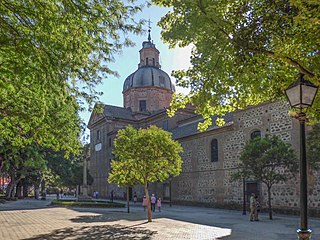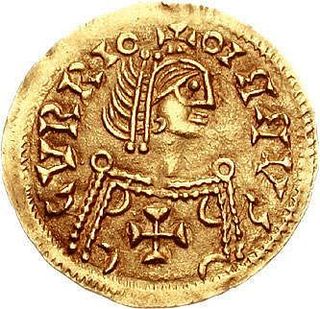Related Research Articles

Toledo is a city and municipality of Spain, capital of the province of Toledo and the de jure seat of the government and parliament of the autonomous community of Castilla–La Mancha. Toledo was declared a World Heritage Site by UNESCO in 1986 for its extensive monumental and cultural heritage.
Castile is a territory of imprecise limits located in Spain. Its extension is often ascribed to the sum of the regions of Old Castile and New Castile, as they were formally defined in the 1833 territorial division of Spain. Those two regions cover the following modern autonomous communities: the eastern part of Castile and León, Castile-La Mancha, and Community of Madrid as well as Cantabria and La Rioja. However, it has been pointed out that in practice the modern limits of Castile are imprecise, and that this name has been used mainly as a reference for the image of Spain as a nation.

The Battle of Covadonga was a battle that took place in 718 or 722 between the army of Pelagius the Visigoth and the army of the Umayyad Caliphate. Fought near Covadonga in the Picos de Europa, either in 718 or 722, it resulted in a victory for the forces of Pelagius. It is traditionally regarded as the foundational event of the Kingdom of Asturias and thus the initial point of the Christian Reconquista ("reconquest") of Spain after the Umayyad conquest of 711.

The Battle of Guadalete was the first major battle of the Umayyad conquest of Hispania, fought in 711 at an unidentified location in what is now southern Spain between the Christian Visigoths under their king, Roderic, and the invading forces of the Muslim Umayyad Caliphate, composed mainly of Berbers and a few Arabs under the commander Ṭāriq ibn Ziyad. The battle was significant as the culmination of a series of Berber attacks and the beginning of the Umayyad conquest of Hispania. Roderic was killed in the battle, along with many members of the Visigothic nobility, opening the way for the capture of the Visigothic capital of Toledo.

Silo was the king of Asturias from 774 to 783, succeeding Aurelius. He came to the throne upon his marriage to Adosinda, daughter of Alfonso I. He moved the capital of the Kingdom of Asturias from Cangas de Onís to Pravia, closer to the center of the kingdom. He was a contemporary of Abd al-Rahman I, Umayyad Emir of Córdoba, and of Charlemagne.

Talavera de la Reina is a city and municipality of Spain, part of the autonomous community of Castile–La Mancha. Its population of 83,303 makes it the second most populated municipality of the province of Toledo and the fourth largest in the region.

García Íñiguez I, also known as García I was the second king of Pamplona from 851–2 until his death. He was the son of Íñigo Arista, the first king of Pamplona. Educated in Cordoba, he was a successful military leader who led the military campaigns of the kingdom during the last years of his father's life.

The County of Barcelona was originally a frontier region under the rule of the Carolingian dynasty. In the 10th century, the Counts of Barcelona became progressively independent, hereditary rulers in constant warfare with the Islamic Caliphate of Córdoba and its successor states. The counts, through marriage, alliances and treaties, acquired the other Catalan counties and extended their influence along Occitania. In 1164, the County of Barcelona entered a personal union with the Kingdom of Aragon. Thenceforward, the history of the county is subsumed within that of the Crown of Aragon, but the city of Barcelona remained preeminent within it. Within the Crown, the County of Barcelona and the other Catalan counties developed a common polity known as the Principality of Catalonia.

An hidalgo or a fidalgo is a member of the Spanish or Portuguese nobility; the feminine forms of the terms are hidalga, in Spanish, and fidalga, in Portuguese and Galician. In popular usage, the term hidalgo identifies a nobleman without a hereditary title. In practice, hidalgos were exempted from paying taxes, yet owned little real property.

Ildefonsus or Ildephonsus was a scholar and theologian who served as the metropolitan Bishop of Toledo for the last decade of his life. His Gothic name was Hildefuns. In the Ethiopian Orthodox Tewahedo Church he is known as Dexius based on the Ge'ez translation of the legends about his life.

The Battle of Clavijo is a mythical battle. "To a serious historian, the existence of the Battle of Clavijo is not even a topic of discussion". However, it was believed for centuries to be historical, and it became a popular theme of Spanish traditions regarding the Christian expulsion of the Muslims. The stories about the battle are first found centuries after it allegedly occurred; according to them, it was fought near Clavijo between Christians, led by Ramiro I of Asturias, and Muslims, led by the Emir of Córdoba.

The National Archaeological Museum is a museum in Madrid, Spain. It is located on Calle de Serrano beside the Plaza de Colón, sharing its building with the National Library of Spain.

San Pedro de la Nave is an Early Medieval church in the province of Zamora, Spain. It is in the locality of El Campillo in the municipal unit of San Pedro de la Nave-Almendra. It was moved from its original site near the River Esla when the land was to be flooded by the construction of the Ricobayo reservoir.

The designation artede (la) repoblación was first proposed by José Camón Aznar in 1949 to replace the term Mozarabic as applied to certain works of architecture from the Christian kingdoms of northern Spain between the end of the 9th and beginning of the 11th centuries. Camón argued that these buildings were related stylistically to the architecture of Asturias and owed little to Andalusian styles. Moreover, since they were built by Christians living under Christian rule, neither were they Mozarabic.

José Orlandis Rovira was a Spanish Roman Catholic priest and historian who wrote more than 200 works, including 20 books.

The Visigothic Kingdom, officially the Kingdom of the Goths, was a kingdom that occupied what is now southwestern France and the Iberian Peninsula from the 5th to the 8th centuries. One of the Germanic successor states to the Western Roman Empire, it was originally created by the settlement of the Visigoths under King Wallia in the province of Gallia Aquitania in southwest Gaul by the Roman government and then extended by conquest over all of Hispania. The Kingdom maintained independence from the Eastern Roman or Byzantine Empire, whose attempts to re-establish Roman authority in Hispania were only partially successful and short-lived.

Claudio Sánchez-Albornoz y Menduiña was an eminent Spanish medieval historian, statesman, and president of the Spanish Republican government in Exile during the rule of Francisco Franco.

Sampiro was a Leonese cleric, politician, and intellectual, one of the earliest chroniclers of post-conquest Spain known by name. He was also the Bishop of Astorga from 1034 or 1035 until his death.

The Battle of Monte Laturce, also known as the second Battle of Albelda, was a victory for the forces of Ordoño I of Asturias and his ally García Íñiguez of Pamplona. They defeated the latter's uncle and former ally, the Banu Qasi lord of Borja, Zaragoza, Terrer, and Tudela, Navarre, Musa ibn Musa ibn Qasi, a marcher baron so powerful and independent that he was called by an Andalusi chronicler "The Third King of the Spains" (Spaniae). The battle took place during the Asturian siege of a new fortress under construction by Musa at Albelda de Iregua. The fortress was taken a few days after the battle. After Monte Laturce, Musa was forced to fully submit to the Emir of Córdoba, who took advantage of Musa's weakness to remove him as wāli of the Upper March, initiating a decade-long eclipse of the Banu Qasi.
The regimiento, cabildo de regidores or concejo cerrado was a system of local government established from the 14h century onwards in the Crown of Castile. A feature of the progressive oligarchization of the form of government in the cities, the change from the overruled concejo abierto system entailed a reduction of the government to a relatively small number of regidores. Urban oligarchies intended to fully capture the nomination of the regidores since the beginning. The bulk of the establishment of the new regime chiefly took place between 1345 and the later years of the reign of Alfonso XI of Castile.
References
Notes
- ↑ Stocking, 336.
- ↑ Kulikowski, 415 n55.
- ↑ Payne, 13.
- ↑ Stocking, 341. For a brief discussion of the fidelis regis in 7th-century Spain, see Castellanos (2003).
- ↑ Stocking, 343.
- ↑ unanimidad internacional en adjetivar de protofeudal a la formación social y política encarnada por el Reino de Toledo a principios del siglo VIII, from Collins (2004), 4, citing Moreno (1992), 17.
- ↑ Kulikowski, 301.
Sources
- Castellanos, Santiago (2003). "The Political Nature of Taxation in Visigothic Spain." Early Medieval Europe, 12, pp. 201–28.
- Castellanos, Santiago and Viso, Iñaki Martín (2005). "The Local Articulation of Central Power in the North of the Iberian Peninsula (500–1000)." Early Medieval Europe, 13 (1), pp. 1–42.
- Collins, Roger J. H. (1984). "Late Antiquity and the Early Middle Ages." Annual Bulletin of Historical Literature, 68 (1), pp. 32–41.
- Collins, Roger J. H. (2004). Visigothic Spain, 409–711. Oxford: Blackwell Publishing. ISBN 0-631-18185-7
- Kulikowski, Michael (2004). Late Roman Spain and Its Cities. JHU Press. ISBN 0-8018-7978-7.
- Moreno, L. García (1992). "El estado protofeudal visigodo: precedente y modelo para la Europa carolingia" in: J. Fontaine and Christine Pellistrandi (edd.), L'Europe héritière de l'Espagne wisigothique. Madrid, pp. 17–43.
- Payne, Stanley G. (1973). A History of Spain and Portugal, Vol. 1. Milwaukee: University of Wisconsin Press.
- Stocking, Rachel L. (2007). "Review article: Continuity, culture and the state in late antique and early medieval Iberia." Early Medieval Europe, 15 (3), pp. 335–348.